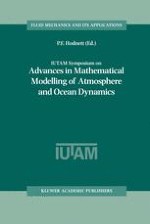2001 | OriginalPaper | Chapter
Linear Resonance, WKB Breakdown, and the Coupling of Rossby Waves over Slowly Varying Topography
Authors : Rémi Tailleux, James C. McWilliams
Published in: IUTAM Symposium on Advances in Mathematical Modelling of Atmosphere and Ocean Dynamics
Publisher: Springer Netherlands
Included in: Professional Book Archive
Activate our intelligent search to find suitable subject content or patents.
Select sections of text to find matching patents with Artificial Intelligence. powered by
Select sections of text to find additional relevant content using AI-assisted search. powered by
WKB theory has been the main analytical tool to investigate the effects of a slowlyvarying topography on barotropic and baroclinic Rossby waves in a horizontally uniform stratified ocean for over three decades now, starting with the pioneering work of (1969). During this period, the main focus was on understanding how the topography modifies the vertical structure of the linear normal modes and the local dispersion relationship (e.g., (1994) and references therein), with little or no attention for their propagation speed and direction. This latter issue was tackled only recently by (1999) (KB99 thereafter), who computed rays and wave amplitudes for baroclinic Rossby waves propagating over realistic topographies (albeit considerably smoothed ones) for the five ocean basins, motivated by the recent analysis of TOPEXlPoseidon altimeter data by (1996). Although KB99’s main result is that large scale topography little impacts the phase speeds and wave amplitudes of first-mode baroclinic Rossby waves (compared with standard, linear, normal -mode theory), in (2000) (TMC hereafter), we questioned the assumption of no scattering between WKB modes upon which KB99 ‘s calculations rely. The support for our claim is illustrated in Fig. 1 which compares the amplitude of annual-period baroclinic Rossby waves excited along an eastern boundary computed by a direct numerical method (left panel) and by means of WKB theory as in KB99 (right panel).
